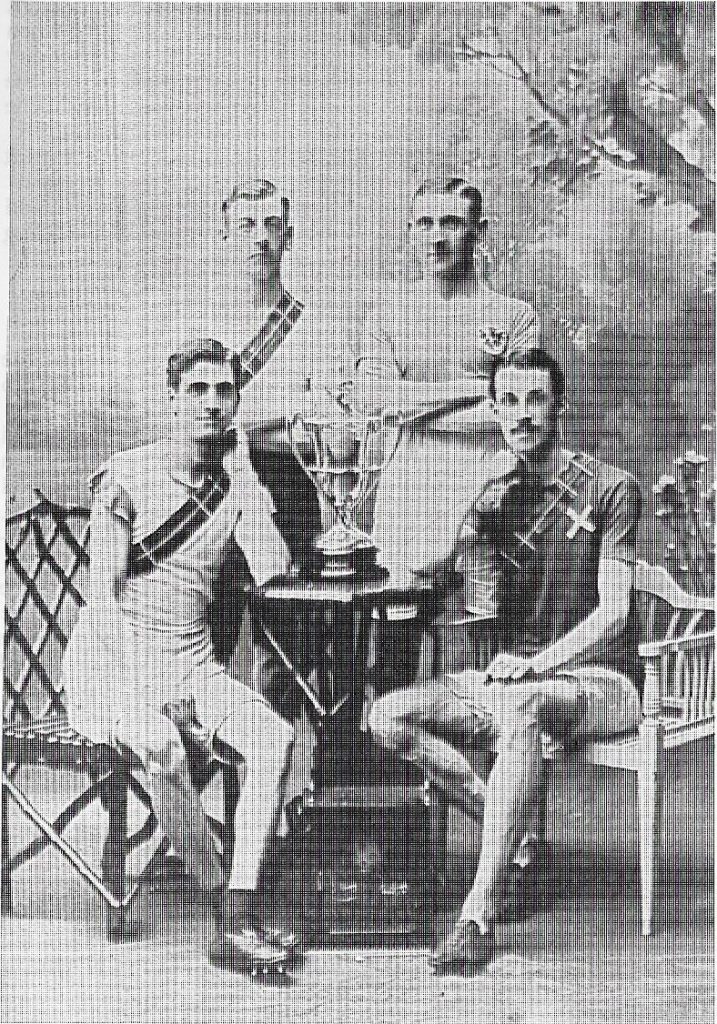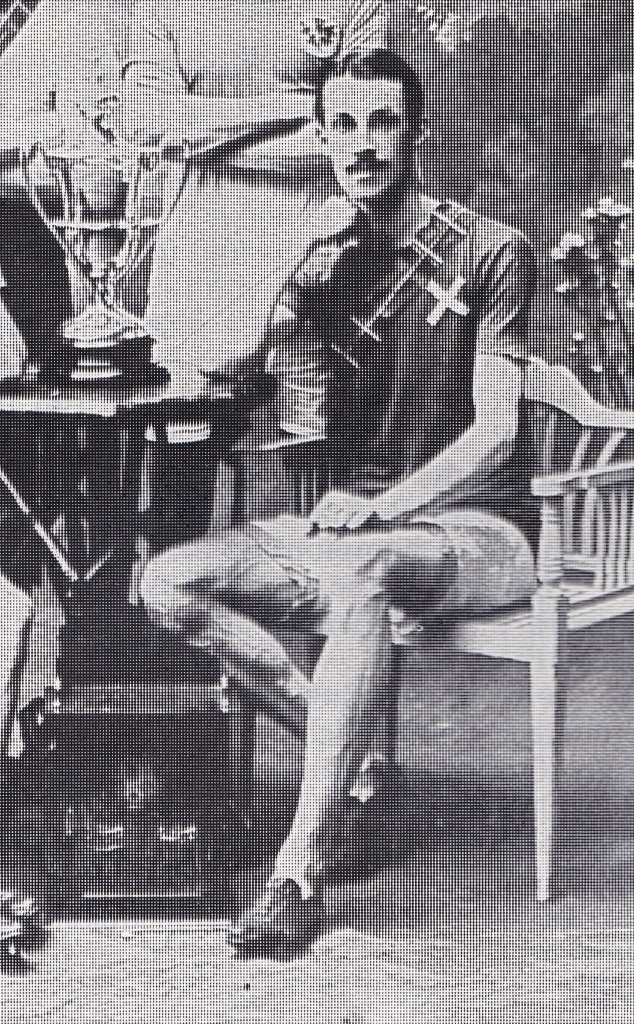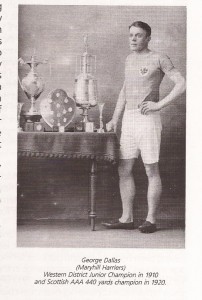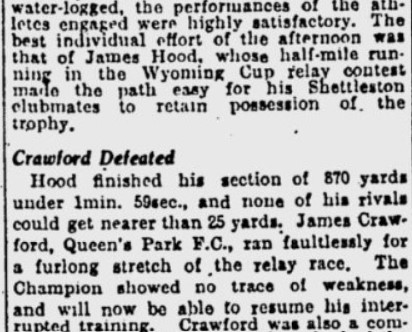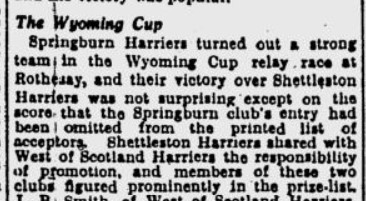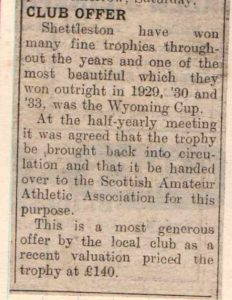The Teviotdale Harriers team which won the Wyoming Cup in the medley Relay at Hawick Common Riding Games in 1910.
WR Sutherland and AJ Grieve standing, and JS Turnbull and RH Burton
Have a look at those spikes!
Scottish ahletics fans always liked relays. Maybe because of the opportunity to see a baton dropped – the same reason for the clustering of spectators at the water jump at a steeplechase – mabe because of the discipline required not only to get the baton to your team mate without mishap, but to do so within a confined space. That was and is true of both 4 x 100 and 4 x 400. But if they liked relays, they loved the medley relay, sometimes called the mile relay which was a bit confusing because the 4 x 440 was also called a mile relay at times. Teams needed an 800m runner, a 400m runner and two 200m men. The mix of distances, the changes of pace and the final shoot-out over a serious distance rather than a quick dash up the track as in the 100 metres/yards. The Scottish way of doing the event was to start with the half mile, follow that with two furlongs and finish with a quarter mile; the English way was to have the quarter first and the half last. There are arguments in favour of both orders but in recent years Scots seem to have given way to the foreign method – much to the irritation of some of us!
Although there was no SAAA Championship for the medley until 1919, the event was hotly contested since before 1909 when the Wyoming Cup was first competed for at Hawick. What follows explains the title but because it was originally featured at the relatively small Hawick amateur meeting, there were results when the result was not published nationally. However it was written up, the first race was on 12th June 1909 and was previewed in the ‘Glasgow Herald’ as follows: “Hawick FC are giving a £20 cup for a relay race on June 12th, and from this district West of Scotland Harriers and Bellahouston Harriers will send teams. The distances are two 220 yards, 440 yards and 880 yards. John McGough will run the half-mile distance for Bellahouston, and either J Fairbairn-Crawford or J Hepburn will represent the West of Scotland Harriers.”
The race was reported in the ‘Glasgow Herald’ on 14th as follows:
“HAWICK. One Mile Team Relay Race for the Wyoming silver challenge cup (presented by Hawick Callants in Wyoming, USA). 1. West of Scotland Harriers (RC Duncan, John Miller, George Hepburn, D Fairbairn Crawford); 2. Heaton Harriers. Crawford finished grandly for the winners, and there was a rare run in between Jameson of Heaton, and Grieve of Teviotdale for second place. The winning team each received a prize worth 20/-.”
In 1910 Teviotdale Harriers, third the year before, won the trophy with a team of AJ Grieve, WR Sutherland, JS Turnbull and RH Burton. Then before the race in 1911, the ‘Glasgow Herald of May 15th, 1911, said: “The Hawick “Callants” who form quite a colony now in Wyoming, and who two years ago gave a handsome challenge cup for the one mile relay at the Hawick Common Riding Sports, are sending home this year £20 as a further donation. In consequence, the Committee have decided to double the value of the prizes for this race. The winning four will receive awards of the value of £2:02:00 and the runners-up and third team prizes will be worth £1:01:00 and 10/6 respectively. The sports will be held on Friday, June 9th, and Mr James Thomson, ex-President of the Scottish Border AAA is again the secretary.”
Came Friday, 9th June and the cup was won by West of Scotland Harriers from a Teviotdale team which was basically the same as the year before, the only change being JM Ballantyne for Turnbull. The Centenary History of Teviotdale Harriers elaborates on the origins of the Trophy as follows.
“Between the years 1909 and 1913 a star attraction at the Common Riding Games was a one-mile team relay for the Wyoming Silver Challenge Cup presented by the Hawick Callants in Wyoming, USA. Valued at 22 guineas, the solid silver cup, weighing over 70 ounces, was supplied by Mr FE Rutherford, jeweller, Hawick, and was according to the rules “open to all amateur harriers clubs in Great Britain and Ireland/” Intimation of the handsome 18″ high cup in the form of a loving cup with three handles, was sent by ‘Teri’ exile Mr Frank Deans who had taken a great interest in athletics when in Hawick. His initiative in procuring 20 subscribers was evidence of the interest he and other exiled Teries had of their native town. “
The trophy was won almost exclusively by either West of Scotland Harriers from Glasgow and Teviotdale Harriers – after three races it was West two wins and Teviotdale one but the score was evened out on 8th June, 1912 when the Glasgow Herald reported: Amateur Sports at Hawick. Team Relay Race for the silver Wyoming Cup and prizes. – 1. Teviotdale Harriers (T Bell, JM Ballantyne, WR Sutherland, RH Burton); 2. West of Scotland Harriers (JH Rodger, RC Duncan, HJ Christie, WS Unkles). Time: 3 min 48 sec.
Robert Burton: the trophy can perhaps be seen more clearly in this one.
Records of the West of Scotland Harriers at this time tell that the entry fee was four shillings and sixpence per team, and the importance of the event was shown in their willingness to pay travelling expenses from Glasgow to Hawick for the runners. eg 1914’s fares and expenses amounted to £2:08:4. In 1913 the situation was complicated. It was a time when it was not unusual for a team which won a trophy three times, or more usually three times in succession, was allowed to keep it for their own use or trophy cabinet and there was a variation written into the rules for the Wyoming Cup. The Teviotdale history again: “the situation for 1913 was that each club had two wins to their credit and the rules stated that three wins would give absolute custody. That year it once again went to West of Scotland and so they claimed permanent possession. Teviotdale’s team of Bell, Ballantyne, Sutherland and Burton were runners-up. Investigation since has revealed that the West team (JH Rodger, RC Duncan, HJ Christie and G Dallas), contrary to the rules laid down for the competition did not comprise a full complement of first claim members, the last named being from Maryhill Harriers, and so in actual fact should have lost the cup by default.”
George Dallas was well known in Scottish athletics and was never anything other than a member of Maryhill Harriers and he was an easy man to recognise as well as being a talented athlete at distances from 100 yards to the half mile. However, the following passage had appeared in the ‘Sports Miscellany’ column of the Glasgow Herald of 19th May, 1913:
“Dallas and Hamilton, both of Maryhill Harriers, have joined the “West”, whose racing ranks are in consequence greatly enriched, as the former is the best half-miler in Scotland, while George Hamilton is one of the best short mark sprinters. It is just possible, however, that Dallas and Hamilton will continue to run in their old colours, though by doing so, they deprive themselves of the privileges which are only shared by those who compete regularly in the pale blue and black stripes of the “West” Harriers.”
It looks as though there was a kind of second-claim connection with the West of Scotland Harriers: eg on 8th July, 1913, Dallas ran in the Maryhill Harriers Sports as ‘G Dallas, Maryhill Harriers.’ Jump to August and in the Rangers FC Sports on the first Saturday, Hamilton was listed in the results as ‘G Hamilton, Maryhill and West of Scotland Harriers’, then a week later he was at Celtic FC Sports as ‘G Hamilton, Maryhill Harriers’. At the Celtic meeting, Dallas was a member of the West team which finished third in the Invitation Relay although he did not appear in the results anywhere else. Was the run at Hawick legal by the standards prevailing? That depends on (a) whether the rules stipulated first or second claim runners only, and (b) what Dallas’s status actually was. The West of Scotland handbook for season 1913/14 reported that “‘The club has competed this season in several Relay Races. At Hawick we won the Wyoming Challenge Cup for the third time, and this now becomes our absolute property.” What happened next to the trophy? West took it home to Glasgow and put it up for competition at some of their meetings which were held frequently over the summer season and. like other Glasgow clubs, they held the occasional meeting at Dunoon.
In 1914 the Hawick Common Riding Sports took place on 6th June and there was a one mile relay – but the Wyoming Cup was not mentioned in the results. The race was won by West of Scotland with a team of J Dallas, G Hamilton, HJ Christie and D McPhee. McPhee had been a Clydesdale Harrier who had joined West in May 1914 and J Dallas is probably George Dallas, again running for the West. Later in the 1914 season at the Celtic FC Sports meeting on 10th August, 1914, George Dallas was entered in a 1000 yards handicap as “G Dallas (West of Scotland Harriers) 35 yards ” However the West club’s handbook for that season pointed out their relay successes: “Our Club has again been very successful in Relay Racing. At Hawick, Greenock (Glenpark Harriers) and our own meeting we won easily over the 880, two 220 and 440 yards, and at Edinburgh Northern Harriers Meeting we were again successful in winning their Challenge Trophy over the four laps’
The West of Scotland Sports at Ibrox on 14th June, 1919, had a relay race which was won by Maryhill Harriers (Dallas, Goodwin, Hamilton and Colberry) over Greenock Glenpark Harriers. There was no mention of the Wyoming Cup but the report on the meeting the following year seems to indicate that it was indeed up for competition. On 12th June 1920 in a report on a West of Scotland Harriers meeting at Ibrox Park, the report credited Duncan McPhee with helping West win the invitation relay over Maryhill saying: He had not a little to do with the winning of the relay race for his club, the West of Scotland Harriers, who thus checked the career of Maryhill Harriers. The latter won the race last year and the two clubs now own one share each in the Wyoming Cup, which becomes the property of the club winning it three times, not necessarily in succession.” The West team was Christie, Todd, Kavanagh and McPhee and the Maryhill squad contained Bell, Colberry, Hamilton and Dallas.
The 1921 race at Ibrox was a joint promotion between West of Scotland and the Glasgow Tramways and was held on 11th June. The report mentioned that the most interesting race on the programme was the mile relay which resolved itself into a duel between West of Scotland and Maryhill Harriers. Dallas and McPhee were the respective half-milers, and the latter ran a great race, finishing a yard ahead and securing the Wyoming Cup for the promoting club.”
10th June 1922 was the date for the next joint West of Scotland Harriers and Glasgow Corporation Tramways AAA meeting at Ibrox and “chief place was given to the relay for the Wyoming Cup, and the West by winning having made the trophy their own for the second time, thanks mainly to the fine running of JCS Ponsford of Glasgow University.” JG McCall, HJ Christie, D McPhee and JCS Ponsford made up the winning team with Shettleston Harriers (Dunbar, Brown, Stevenson and Annand) second. The comment about the West having made the trophy their own indicated to the public that they had won the relay in three consecutive years. This did not stop them putting it up for competition the next year: the race was again held at Ibrox Park and the ‘Glasgow Herald’ in its ‘Notes on Sports’ column of 11th June, 1923, had a special paragraph headed
THE WYOMING CUP
The Harrier clubs in the West who promote open meetings are, of necessity, optimists of the first degree, otherwise the apathy of the public would have cured them of the habit long ere now. Not even the relay race for the Wyoming Cup nor the opportunity of seeing a quarter-mile over hurdles could induce more than a meagre sprinkling of spectators to line the ropes at Ibrox Park, where West of Scotland held their meeting on Saturday. Yet the racing throughout was of the honest description and the times returned in most of the events were quite good. The chief feature did not provide a thrilling race – the superiority of the promoting club when the final quarter was entered was too pronounced for that – but two of the competitors ran very well. These were George Malcolm of the Edinburgh Southern Harriers, who exhibited a fine burst of speed against McPhee in the half-mile and was only beaten by a few yards, and AH Graham of Maryhill Harriers whose effort in the final quarter was worthy of a better fate. AM McKay of Leith ran for Edinburgh Southern but his display over the furlong clearly showed that the Inter-Scholastic champion’s best distance is the quarter. West’s victory, their fourth in succession, was gained by 10 yards from Maryhill Harriers, the other two competing clubs, Edinburgh Southern and Bellahouston Harriers, finishing well down.”
The Inter-Scholastic Championships referred to were the fore runners of the Scottish Schools championships but contested mainly by the fee-paying schools pupils. In the results column, the Cup was again referred to as the chief event in the programme – Scots did and still do like their rrelays and the Mile medley (880, 220,220, 440) had a special place in their affections, and for the clubs concerned it was a magnificnt piece of silverware that FE Rutherford had crafted all those years before.
1924 was Olympic Games year and with selection for the British team important, the SAAA Championships were brought forward to the second Saturday in June – the date of the West of Scotland meeting. With almost every Saturday already being the focus for one established meeting or another (eg Queen’s Park FC, Greenock Glenpark Harriers, Glasgow Police, Partick Thistle all had their regular dates in June or early July) there was no week end sports put on by West of Scotland.
There was no meeting held by West of Scotland in June 1925, either on their own or in tandem with the Tramways or Shettleston, although on June 22nd at the Glasgow Police Sports at Ibrox the mile medley relay was won by Maryhill from West of Scotland Harriers, Calderwood, Duncan, Graham and McCrae making up the team.
On Tuesday June 15th, 1926, the relay for the Wyoming Cup was held once again. This time at the joint Shettleston/West of Scotland Harriers meeting at Ibrox Park. It was won by West of Scotland, represented by McIntyre, Burns, Urquhart and Hope from Shettleston Harriers who had Tom Riddell on the opening half-mile stage, followed by Crawford, Harrison and Stanley. The report commented: “Riddell ran again for Shettleston Harriers in the relay race for the Wyoming Cup and the five yards lead he gained from RB McIntyre gave his side a lead which was maintained until the final quarter. Here JD Hope running very strongly finished an easy winner by 15 yards.”
11th June, 1927 at Celtic Park, the intro read “the chief event of the meeting, the Wyoming Cup for the one mile relay, was won by West of Scotland Harriers after an interesting struggle with Maryhill Harriers.” The team was made up of Mcintyre, Burns, McLean and Hope and the winning time was 3 min 42 3-5th sec.
On the second Saturday of June 1928 most meetings in the West were cancelled because of the weather, only those at Clydebank (Singer’s Sports) and Glasgow University OTC went ahead – although the Hawick Common Riding Sports were ‘ carried through under favourable track conditions as the times returned in various events would suggest.” The one mile relay there was won by Edinburgh University AC from English team, Gateshead Congers. 1928 also saw the birth of a series of annual big inter-club meetings organised by St Peter’s AAC at Scotstoun in Glasgow.
These meetings consisted of a whole series of relays from 4 x 110 yards to four miles relay and including the half mile relay, 4 x 440 yards hurdles relay, mile relay and two miles relay as well as the mile team race, the three miles team race as well as many standard field events. These were held in the middle of June and they may have been a factor in the virtual disappearance of the West of Scotland Harriers meetings.
This is where things get complicated however: although the trail goes cold as far as newspaper reports are concerned, the West of Scotland archive has some information. These contain dates for the “cleaning and engraving of their trophies: in 1920 they specify the Wyoming Cup. In 1928 the relays were mentioned and the engraving was carried out by James McMenamin, engraver. As is the way with different secretaries, details of items such as “engraving and cleaning” are more or less detailed from year to year but after several years of this entry, the note for June 16th 1933 mentions the engraving of the Wyoming Cup at a cost of 7/-. What does all this tell us? It tells us that the cup was in circulation at this time but not what it was awarded for or to whom it was awarded,
*
